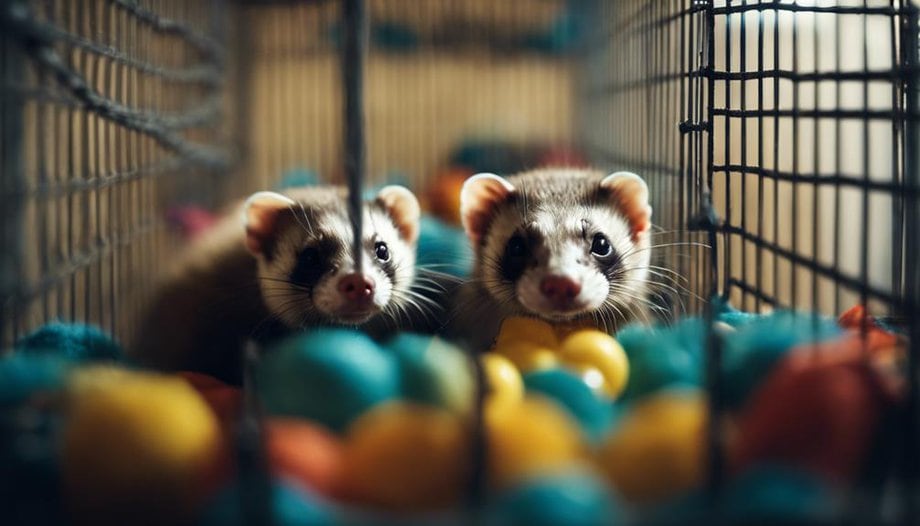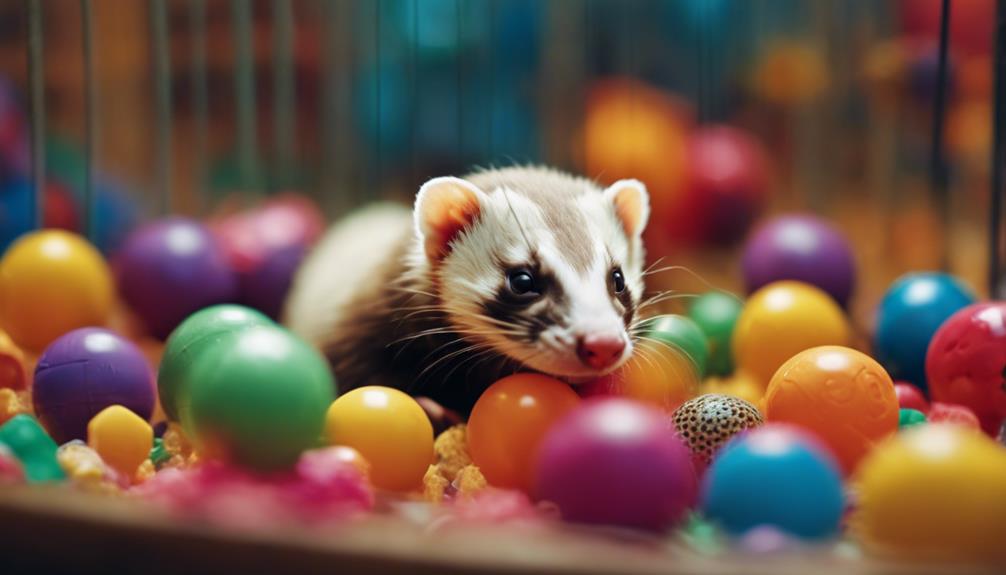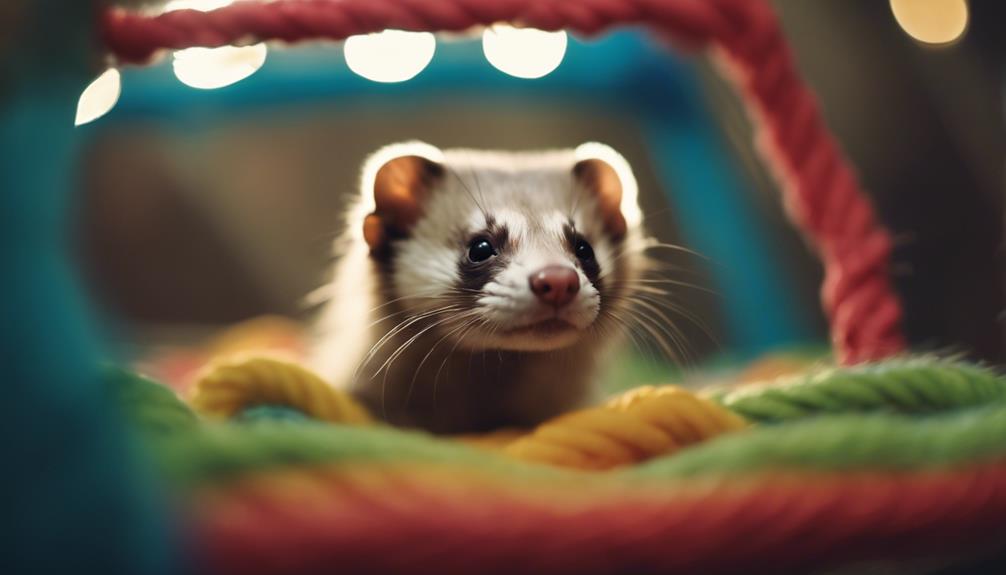How to Create a Stimulating Environment Inside a Ferret Cage

Ferrets are highly curious and active animals that require a stimulating environment to thrive. When setting up a cage for your ferret, it's essential to include various elements that cater to their natural behaviors and instincts.
Ensure the cage is spacious enough to allow for exploration and exercise. Include multiple levels, ramps, and tunnels to encourage climbing and physical activity. Provide a variety of toys such as tunnels, balls, and chew toys to keep your ferret mentally engaged.
Incorporate hiding spots and cozy bedding for your ferret to rest and feel secure. Consider adding hammocks or hanging beds for additional comfort. Place a litter box in one corner of the cage to promote good hygiene habits.
Regularly rotate and introduce new toys to prevent boredom and keep your ferret stimulated. Additionally, provide opportunities for your ferret to interact with you outside of the cage through playtime and bonding activities. By creating a stimulating environment, you can ensure that your ferret remains happy and healthy.
Cage Layout and Design
When designing the layout of a ferret cage, it's crucial to consider both the physical and mental stimulation needs of these curious and intelligent creatures. Providing climbing structures and play areas is essential for keeping ferrets active and engaged. Multi-level platforms offer them the opportunity to explore different heights, mimicking their natural instinct to climb and survey their surroundings. Enrichment items such as tunnels, hammocks, and interactive toys can also help keep ferrets mentally stimulated and prevent boredom.
To create a stimulating environment, ensure that there are plenty of opportunities for your ferret to climb and explore. Place ramps and shelves strategically to encourage movement and provide access to different levels within the cage. Incorporating hiding spots and cozy corners can give your ferret a sense of security and privacy. By offering a variety of climbing structures, play areas, multi-level platforms, and enrichment items, you can design a cage layout that meets the physical and mental needs of your furry friends.
Fun Tunnel Systems

To enhance the stimulating environment of a ferret cage, incorporating fun tunnel systems can provide engaging pathways for exploration and play. Tunnel mazes offer mental stimulation and physical activity for ferrets, keeping them entertained and preventing boredom. Playtime tunnels create opportunities for exploration, mimicking their natural instinct to burrow and navigate through tunnels. These tunnel systems not only serve as a source of enrichment but also encourage exercise, which is crucial for the health and well-being of ferrets.
| Tunnel Type | Description |
|---|---|
| Tunnel Mazes | Complex network of tunnels for mental stimulation. |
| Enrichment Tunnels | Provide interactive elements for a fun experience. |
| Playtime Tunnels | Encourage exploration and physical activity. |
| Exploration Tunnels | Stimulate curiosity and mimic wild behaviors. |
Cozy Hammocks and Beds

Cozy hammocks and beds provide essential comfort and relaxation for ferrets in their cage environment. Fleece bedding offers a soft and warm surface for ferrets to snuggle into, creating a cozy corner for them to rest and sleep. These plush nests are perfect for ferrets to unwind and feel secure in their space.
Hanging hideaways add an extra layer of fun and comfort, giving ferrets a sense of privacy and seclusion when they need some alone time.
When selecting hammocks and beds for ferrets, it's important to choose materials that are safe and easy to clean. Opt for durable fabrics that can withstand ferrets' playful nature and are machine washable for convenience. Additionally, ensure the hammocks and beds are securely attached to the cage to prevent any accidents.
Interactive Toy Selection

Ferrets thrive in enriched environments that cater to their natural instincts and behaviors, making interactive toy selection a crucial aspect of their mental and physical well-being. When choosing toys for ferrets, it's essential to consider activities that stimulate their curiosity, encourage physical exercise, and promote mental engagement. Puzzle feeders are a fantastic option as they provide mental stimulation while satisfying their natural foraging instincts. Bonding activities, such as interactive toys that encourage play between ferrets and their owners, help strengthen the human-ferret bond and provide social enrichment.
Here is a table showcasing different types of interactive toys that can benefit your ferret's well-being:
| Toy Type | Description |
|---|---|
| Puzzle Feeders | Toys that require problem-solving skills for food rewards. |
| Bonding Activities | Toys that facilitate play and interaction between ferrets and their owners. |
| DIY Projects | Homemade toys that promote creativity and mental stimulation. |
| Enrichment Games | Toys designed to encourage physical activity and mental engagement. |
Selecting a variety of interactive toys, including puzzle feeders and bonding activities, can offer your ferrets both physical exercise and mental enrichment, keeping them happy and healthy.
Enriching Foraging Opportunities

When enriching foraging opportunities for ferrets, incorporating food puzzle toys and hide-and-seek games can provide mental stimulation and encourage natural behaviors.
Food puzzle toys challenge ferrets to work for their food, promoting problem-solving skills and preventing boredom.
Hide-and-seek games can engage their curiosity and mimic hunting behaviors, keeping them active and entertained.
Food Puzzle Toys
Enhancing a ferret's environment with food puzzle toys provides valuable mental stimulation and enriches their foraging opportunities. These toys encourage mental stimulation through problem-solving, keeping the ferret entertained while providing essential exercise.
By incorporating food puzzle toys into their daily routine, ferrets engage in natural foraging behaviors, preventing boredom and promoting physical activity. These toys come in various forms, such as balls with hidden compartments for treats or interactive feeders that require manipulation to dispense food.
Watching a ferret play with a food puzzle toy can be both entertaining and rewarding, as it taps into their instinctual behaviors. Overall, these toys not only provide a source of enrichment but also contribute to the overall well-being of the ferret.
Hide-And-Seek Games
To enhance a ferret's foraging instincts and mental agility, incorporating hide-and-seek games into their daily routine can provide enriching opportunities for stimulation. Playful distractions and camouflage challenges can keep ferrets engaged and mentally sharp. Seek and find games tap into their natural hunting instincts, providing both physical and mental exercise. Creating surprise hideouts where they can search for treats or toys encourages exploration and problem-solving skills. These activities mimic their natural behaviors in the wild, promoting a sense of fulfillment and contentment. By setting up various hiding spots and rotating them regularly, ferrets stay mentally stimulated and entertained. Engaging in hide-and-seek games not only provides mental enrichment but also strengthens the bond between pet and owner.
| Playful Distractions | Camouflage Challenges | Seek and Find |
|---|---|---|
| Encourages engagement | Tests mental agility | Stimulates hunting instincts |
| Provides mental exercise | Promotes problem-solving | Enhances exploration |
| Mimics natural behaviors | Fosters fulfillment | Strengthens owner-pet bond |
Creative Hiding Spots

Amidst the plethora of accessories available for a ferret's cage, strategically placed items can create an engaging environment that offers creative hiding spots for these curious creatures. Secret hideaways and DIY projects can be incorporated to provide ferrets with camouflaged burrows and imaginative solutions for their hiding needs.
One creative hiding spot idea is to utilize PVC pipes to create tunnels and hideouts within the cage. By connecting these pipes in various ways, ferrets can enjoy exploring and hiding in their personalized maze.
Another simple yet effective hiding spot can be fashioned by repurposing an old flowerpot. By turning it on its side and filling it with soft bedding, ferrets can snuggle up inside, creating a cozy and secure retreat. Hanging hammocks at different levels in the cage also offer ferrets a fun and elevated hiding spot where they can relax and observe their surroundings.
Regular Cage Maintenance

When caring for ferrets in a stimulating cage environment, ensuring regular maintenance is essential to promote their health and well-being. Establishing a consistent cleaning schedule is crucial to prevent the buildup of bacteria and odors. It's recommended to clean the cage thoroughly at least once a week, removing all bedding, toys, and cage accessories for a deep clean. Sanitizing methods such as using pet-safe disinfectants or a vinegar-water solution can help eliminate germs effectively.
In addition to regular cleaning, maintaining cage accessories is vital. Check toys and accessories for any signs of wear and tear, replacing them as needed to prevent any potential hazards to the ferrets. Proper odor control is also essential in a ferret's living space. Using odor-absorbing bedding and regularly cleaning litter boxes can help keep the cage smelling fresh and clean.
Frequently Asked Questions
How Can I Introduce My Ferret to a New Toy or Enrichment Item?
When introducing a new toy or enrichment item to a ferret, start by placing it in their environment during playtime. Ensure the item is safe and offers mental and physical stimulation. Rotate toys regularly to keep playtime engaging and beneficial for their well-being.
Are There Any Specific Materials I Should Avoid When Selecting Bedding for My Ferret's Cage?
Is your ferret's health a top priority? When choosing bedding, opt for safe materials like paper-based bedding or fleece liners. Stay away from cedar or pine shavings as they contain harmful substances that can affect your ferret's well-being.
What Are Some Signs That My Ferret May Be Bored or Under-Stimulated in Their Cage?
Signs of boredom in ferrets include increased sleeping, excessive chewing, and repetitive behaviors. Behavioral changes may also indicate boredom. To combat this, adjust the cage layout, introduce new toys, and establish diverse playtime routines.
Can I Use Household Items to Create DIY Enrichment Activities for My Ferret?
One can indeed use household items creatively to fashion DIY enrichment ideas for a ferret, offering them unique playtime opportunities. With a touch of ingenuity and care, these makeshift toys can bring joy and mental stimulation to furry companions.
How Often Should I Change Out or Rotate My Ferret's Toys and Enrichment Items to Keep Them Engaged?
To keep ferrets engaged, rotate toys every few days and introduce new enrichment items regularly. Vary cage setup for mental stimulation. Aim for daily playtime to ensure physical activity and bonding. Meeting these needs fosters a happy, healthy ferret.











